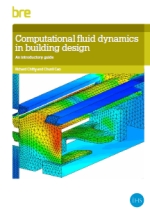Computational fluid dynamics in building design: An introduction FB 69
BRE (Building Research Establishment) is an independent, research-based consultancy, testing and training organisation, operating in the built environment and associated industries.
Computational fluid dynamics in building design: An introduction (FB 69) was written by Richard Chitty and Chunli Cao and published on 15 September 2014.
Computational fluid dynamics (CFD) is a tool that can be used in the design of buildings to simulate aspects of a building's thermal and ventilation performance, fire engineering, its impact on the local environment and so on. For more information see: Computational fluid dynamics.
FB 69 sets out the background to the CFD methodology for non-experts such as building control bodies and other regulatory authorities and discusses the current capabilities and limitations of CFD for building design.
The process of reviewing CFD predictions can be dependent on identifying ‘schoolboy’ errors, such as supersonic wind speeds, using simple sanity checks based on experience of the real world. Visualisation methods often mask the difference between qualitative simulations to demonstrate the feasibility of a concept and quantitative simulations required to prove the functionality of different aspects of design.
The 32-page guide explains best practice, focussing on fire safety, ventilation, thermal comfort and wind movement around buildings.
Its contents include:
- Introduction.
- Computational fluid dynamics explained.
- Computational fluid dynamics in use.
- Fire safety design.
- Ventilation and thermal comfort.
- Wind loading.
- Micro-climate around buildings.
- Case study 1: Fire simulation.
- Case study 2: Natural ventilation.
- References.
[edit] Related articles on Designing Buildings Wiki
- A Practical Guide to Building Thermal Modelling.
- BRE articles on Designing Buildings Wiki.
- BRE Buzz articles on Designing Buildings Wiki.
- BRE Buzz.
- Building Research Establishment.
- Computational fluid dynamics.
- Conventions for calculating linear thermal transmittance and temperature factors.
- Dynamic thermal modelling of closed loop geothermal heat pump systems.
- Heat transfer.
- Indoor air velocity.
- Integrating CFD into the design process.
- Mass transfer.
- The design of temporary structures and wind adjacent to tall buildings.
- The thermal behaviour of spaces enclosed by fabric membranes (Thesis).
- Thermal dynamic analysis.
Featured articles and news
Professional practical experience for Architects in training
The long process to transform the nature of education and professional practical experience in the Architecture profession following recent reports.
A people-first approach to retrofit
Moving away from the destructive paradigm of fabric-first.
International Electrician Day, 10 June 2025
Celebrating the role of electrical engineers from André-Marie Amperè, today and for the future.
New guide for clients launched at Houses of Parliament
'There has never been a more important time for clients to step up and ...ask the right questions'
The impact of recycled slate tiles
Innovation across the decades.
EPC changes for existing buildings
Changes and their context as the new RdSAP methodology comes into use from 15 June.
Skills England publishes Sector skills needs assessments
Priority areas relating to the built environment highlighted and described in brief.
BSRIA HVAC Market Watch - May 2025 Edition
Heat Pump Market Outlook: Policy, Performance & Refrigerant Trends for 2025–2028.
Committing to EDI in construction with CIOB
Built Environment professional bodies deepen commitment to EDI with two new signatories: CIAT and CICES.
Government Grenfell progress report at a glance
Line by line recomendation overview, with links to more details.
An engaging and lively review of his professional life.
Sustainable heating for listed buildings
A problem that needs to be approached intelligently.
50th Golden anniversary ECA Edmundson apprentice award
Deadline for entries has been extended to Friday 27 June, so don't miss out!
CIAT at the London Festival of Architecture
Designing for Everyone: Breaking Barriers in Inclusive Architecture.
Mixed reactions to apprenticeship and skills reform 2025
A 'welcome shift' for some and a 'backwards step' for others.























